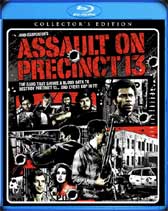 ASSAULT
ON PRECINCT 13 (1976) Blu-ray
ASSAULT
ON PRECINCT 13 (1976) Blu-rayScream Factory/Shout! Factory
Director: John Carpenter
 ASSAULT
ON PRECINCT 13 (1976) Blu-ray
ASSAULT
ON PRECINCT 13 (1976) Blu-rayJohn Carpenter's first truly Carpenter-esque film ASSAULT ON PRECINCT 13 gets the "Scream Factory" treatment on Shout! Factory's brand new collector's edition Blu-ray.
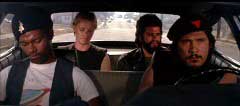
After six members of the Street Thunder gang are massacred by the LAPD in an early morning raid, its leaders swear a blood oath against the police (and anyone else that literally strays into their crosshairs). On his first night out, newly-promoted Lieutenant Ethan Bishop (Austin Stoker, HORROR HIGH) is assigned to what seems like a boring assignment taking over for the captain of the Anderson precinct (that's precinct 9, district 13) – in the middle of a largely derelict neighborhood – on its last night of operation. He doesn't realize however, that he and the staff – as well as dangerous criminals Napoleon Wilson (Darwin Joston, THE FOG) and Wells (Tony Burton, Kubrick's THE SHINING) on an unfortunate stopover – are in for a "white hot night of hate". When a grieving father (Martin West, HELLHOLE) retaliates for the brutal slaying of his daughter ("Real Housewife" Kim Richards, ESCAPE TO WITCH MOUNTAIN) by gunning down one of the gang's leaders (Frank Doubleday, ESCAPE FROM NEW YORK), the catatonic man brings Street Thunder to their doorstep. The military-style gang cut off their power and phone lines and wage a battle with silencers, doing maximum damage with little disturbance to attract patrolling police (who have only received complaints of fireworks with no specific location)
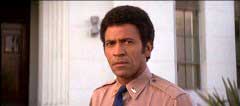 Although
Not John Carpenter’s directorial debut, ASSAULT ON PRECINCT 13 was the
first of his Panavision-lensed works – shot by USC colleague Douglas Knapp
(THE LOVE GARDEN) – and his first solo venture (DARK STAR was co-directed
by Dan O'Bannon). A more blatant homage to Howard Hawks and specifically RIO
BRAVO – the film's working title was "The Anderson Alamo" –
than any of his other works, the film is still remarkably accomplished and feels
more like what one identifies as a John Carpenter film (it really should have
been called JOHN CARPENTER'S ASSAULT ON PRECINCT 13 but he would not adapt the
possessory credit until HALLOWEEN) more so that DARK STAR or even his memorable
pre-HALLOWEEN made-for-TV suspenser SOMEONE'S WATCHING ME. The action sequences
are not only technically slick and tense, but their lengthy duration (along
with shots of piles of paper exploding into the air) anticipates the famous
five minute fistfight of THEY LIVE although the laughter it raises is more nervous
than the latter. As secretary Leigh, Laurie Zimmer comes across a little forced
at first in her Hawksian "Lauren Bacall", but her stoicism is soon
just as badass as Joston's Napoleon Wilson (both really should have gone on
to more prominent work, even if only in subsequent Carpenter films) while the
more naturalistic Stoker and Burton provide a good contrast to the two until
Wilson and Wells engage in game of "One Potato, Two Potato". The film
also features Charles Cyphers (ELVIS) and Nancy Loomis (HALLOWEEN III: SEASON
OF THE WITCH) in the first of their appearances in Carpenter's early works.
Sure, they've got victim painted on both of their foreheads, but they are still
it's as much a pleasure to see them as it is in they're more memorable and snarkier
appearances in HALLOWEEN and THE FOG. Carpenter's scoring is at its most minimalistic
and technically primitive here, but is more than up to underlining the film's
suspense and its melancholy (particularly the theme for Loomis' character).
Carpenter's early producing partner Debra Hill served as the film's script supervisor
and assistant editor.
Although
Not John Carpenter’s directorial debut, ASSAULT ON PRECINCT 13 was the
first of his Panavision-lensed works – shot by USC colleague Douglas Knapp
(THE LOVE GARDEN) – and his first solo venture (DARK STAR was co-directed
by Dan O'Bannon). A more blatant homage to Howard Hawks and specifically RIO
BRAVO – the film's working title was "The Anderson Alamo" –
than any of his other works, the film is still remarkably accomplished and feels
more like what one identifies as a John Carpenter film (it really should have
been called JOHN CARPENTER'S ASSAULT ON PRECINCT 13 but he would not adapt the
possessory credit until HALLOWEEN) more so that DARK STAR or even his memorable
pre-HALLOWEEN made-for-TV suspenser SOMEONE'S WATCHING ME. The action sequences
are not only technically slick and tense, but their lengthy duration (along
with shots of piles of paper exploding into the air) anticipates the famous
five minute fistfight of THEY LIVE although the laughter it raises is more nervous
than the latter. As secretary Leigh, Laurie Zimmer comes across a little forced
at first in her Hawksian "Lauren Bacall", but her stoicism is soon
just as badass as Joston's Napoleon Wilson (both really should have gone on
to more prominent work, even if only in subsequent Carpenter films) while the
more naturalistic Stoker and Burton provide a good contrast to the two until
Wilson and Wells engage in game of "One Potato, Two Potato". The film
also features Charles Cyphers (ELVIS) and Nancy Loomis (HALLOWEEN III: SEASON
OF THE WITCH) in the first of their appearances in Carpenter's early works.
Sure, they've got victim painted on both of their foreheads, but they are still
it's as much a pleasure to see them as it is in they're more memorable and snarkier
appearances in HALLOWEEN and THE FOG. Carpenter's scoring is at its most minimalistic
and technically primitive here, but is more than up to underlining the film's
suspense and its melancholy (particularly the theme for Loomis' character).
Carpenter's early producing partner Debra Hill served as the film's script supervisor
and assistant editor.
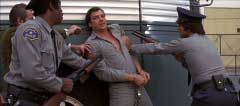
Released on VHS in a panned-and-scanned version by Media Home Entertainment in 1983, ASSAULT ON PRECINCT 13 first got the special edition treatment via Image Entertainment in 1997 with a widescreen transfer, commentary by John Carpenter, and the score isolated on the analog right channel. Since then, the film has had three DVD releases via Image Entertainment starting with a 1997 non-anamorphic letterbox DVD (with Carpenter’s commentary and the trailer), a 2003 HD-mastered anamorphic special edition with the commentary, isolated music score, a Q&A with Carpenter and Stoker, and a few more extras, and lastly a 2008 edition with DTS and Dolby Digital 5.1 remixes which coincided with their Blu-ray release. I haven’t seen the 2008 edition, but the 2003 version was a touch greenish with warm skintones (the Scream disc looks a bit more naturalistic in most scenes, although the lighted precinct interior scenes accentuate the yellows due to the light sources and the color of the walls, badges, Loomis' sweater, almost enough to make one think they were shot with a yellow filter or had the color dialed up). Framing is consistent between the two transfers, but it's more apparent here that some dark scenes were brightened in post. Like the earlier editions, there is a patch of footage from an inferior source when Leigh frees Wells and Wilson from the cells. The mono mix is available in lossless DTS-HD Master Audio 2.0 (the Image disc had the mono mix in Dolby Digital, but the German Blu-ray has the track in uncompressed LPCM 2.0) as well as a DTS-HD Master Audio 5.1 upmix. The surround mix is still very front-oriented but it does give the score and the sound effects some breathing room (although art director/sound effects editor Wallace does mention on the commentary track how simple – intentionally so – the mix really was). As on the earlier releases, Carpenter's isolated score is available as a listening option here (although it is encoded in Dolby Digital as it was on the Image release).
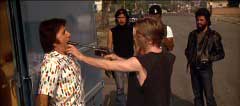 The
John Carpenter commentary is ported over from the laserdisc (and the DVD and
Blu editions since them) in which he cops to taking the basic premise of RIO
BRAVO (Carpenter's pseudonym for the editing is "John T. Chance")
and reworking it (although he also notes the similarities to NIGHT OF THE LIVING
DEAD). He discusses his decision to have a multi-ethnic gang (perhaps to not
liken any one group to the western genre's "savage" Indian characters).
He points out places in which the scenes drag not due to the general slower
pacing of films from the period but because he didn't have adequate coverage
to cut away. He also humorously remarks on how difficult it was to make their
downtown Los Angeles locations look dangerous (the neighborhood was deserted
because it had been bought by the city to build a freeway, but it was not as
decrepit as they had to make it look). He describes the writing as the "production
of a young man's writing" but "unfiltered by Hollywood cynicism";
and that the film is more rooted in forties melodrama than seventies "jive".
The heavy-handed recurring cigarette gags are another reference to Hawks (particularly
THE BIG SLEEP). Carpenter has no moderator here, but he more talkative here
than in some later tracks (mostly because he points out what he would have done
differently now, but he take sole responsibility for the flaws he perceives).
His admiration for his collaborators is evident throughout, and he describes
the film as a "labor of love" (he didn't take a salary) like HALLOWEEN.
The
John Carpenter commentary is ported over from the laserdisc (and the DVD and
Blu editions since them) in which he cops to taking the basic premise of RIO
BRAVO (Carpenter's pseudonym for the editing is "John T. Chance")
and reworking it (although he also notes the similarities to NIGHT OF THE LIVING
DEAD). He discusses his decision to have a multi-ethnic gang (perhaps to not
liken any one group to the western genre's "savage" Indian characters).
He points out places in which the scenes drag not due to the general slower
pacing of films from the period but because he didn't have adequate coverage
to cut away. He also humorously remarks on how difficult it was to make their
downtown Los Angeles locations look dangerous (the neighborhood was deserted
because it had been bought by the city to build a freeway, but it was not as
decrepit as they had to make it look). He describes the writing as the "production
of a young man's writing" but "unfiltered by Hollywood cynicism";
and that the film is more rooted in forties melodrama than seventies "jive".
The heavy-handed recurring cigarette gags are another reference to Hawks (particularly
THE BIG SLEEP). Carpenter has no moderator here, but he more talkative here
than in some later tracks (mostly because he points out what he would have done
differently now, but he take sole responsibility for the flaws he perceives).
His admiration for his collaborators is evident throughout, and he describes
the film as a "labor of love" (he didn't take a salary) like HALLOWEEN.
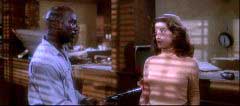 Scream
Factory have recorded a brand new commentary track with Tommy Lee Wallace moderated
by Red Shirt Pictures' Michael Felsher. Wallace had already contributed a commentary
track for the company's special edition of THE FOG, and he's just as informative
here since he was not only on set as the art director, but also in post-production
cutting sound effects (he had no prior experience in that area but asked Carpenter
for something to do during that period). A childhood friend of Carpenter's back
in Bowling Green, Kentucky, Wallace jokes about the gang's diverse ethnic makeup
(he calls them "the United Nations of gangs") as well as the film's
Cadillac style on a Volkswagen budget; that is, Carpenter's insistence on using
the anamorphic shooting format (Panavision) – whose lenses then required
more light than spherical ones – as well as the best lab (Metrocolor) to
process the film and sound studio (Goldwyn) to mix it. Although the novel use
of silencers was not intended to do so, Wallace discusses how their use in place
of traditional gunfire on the sound effects track emphasized the impact of the
bullet hits (which would have been otherwise muffled by the shots themselves).
Of Richards' death scene, Felsher suggests that it is so brutal so as to definitively
define the gang as the bad guys while Wallace says it was a deliberately provocative
scene in order to compete in the exploitation film arena. Wallace also reveals
that he provided temp voice-overs for the Carpenter films he worked on, some of
which were retained for the final mix like the announcer on KAB's jingles on THE
FOG and the voice on the police radio here that tells Bishop "There are no
heroes anymore, only men who follow orders." Wallace also mentions his collaborations
with fellow art directors Randy Moore (SHOCKER) – who plays one of the gang
members here – and Craig Stearns (ROSE RED) who is credited here with props.
Scream
Factory have recorded a brand new commentary track with Tommy Lee Wallace moderated
by Red Shirt Pictures' Michael Felsher. Wallace had already contributed a commentary
track for the company's special edition of THE FOG, and he's just as informative
here since he was not only on set as the art director, but also in post-production
cutting sound effects (he had no prior experience in that area but asked Carpenter
for something to do during that period). A childhood friend of Carpenter's back
in Bowling Green, Kentucky, Wallace jokes about the gang's diverse ethnic makeup
(he calls them "the United Nations of gangs") as well as the film's
Cadillac style on a Volkswagen budget; that is, Carpenter's insistence on using
the anamorphic shooting format (Panavision) – whose lenses then required
more light than spherical ones – as well as the best lab (Metrocolor) to
process the film and sound studio (Goldwyn) to mix it. Although the novel use
of silencers was not intended to do so, Wallace discusses how their use in place
of traditional gunfire on the sound effects track emphasized the impact of the
bullet hits (which would have been otherwise muffled by the shots themselves).
Of Richards' death scene, Felsher suggests that it is so brutal so as to definitively
define the gang as the bad guys while Wallace says it was a deliberately provocative
scene in order to compete in the exploitation film arena. Wallace also reveals
that he provided temp voice-overs for the Carpenter films he worked on, some of
which were retained for the final mix like the announcer on KAB's jingles on THE
FOG and the voice on the police radio here that tells Bishop "There are no
heroes anymore, only men who follow orders." Wallace also mentions his collaborations
with fellow art directors Randy Moore (SHOCKER) – who plays one of the gang
members here – and Craig Stearns (ROSE RED) who is credited here with props.
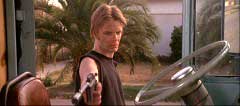 The
2002 Q&A between Carpenter and Stoker (23:06) has been ported over from
the 2003 Image edition. Carpenter discusses the Hawks inspiration, the cast
(Zimmer hated her deadpan performance for the very reasons that most like it,
and Joston was Carpenter's neighbor and the inspiration for his character),
the stunts and special effects, and dealing with the MPAA (they wanted to give
it an X for Richards' death alone and the distributor instructed Carpenter to
edit it, screen it again for the MPAA, and then put the shot back in). The audience
is pretty savvy, tittering when the moderator asks how much time Carpenter and
his cast had for rehearsals. Stoker discusses his beginnings on the stage in
New York, and mentions that both Joston and West were in the acting classes
he attended in New York, and he believes that Joston was the one who recommended
him to Carpenter (who cast him without an audition). Stoker also appears in
a new interview (7:47) and there is a lot of overlap with the Q&A but the
audio is better and it's more recent. Like most viewers, he too wonders why
Zimmer left the business. The SD digital video for this featurette always looked
softish.
The
2002 Q&A between Carpenter and Stoker (23:06) has been ported over from
the 2003 Image edition. Carpenter discusses the Hawks inspiration, the cast
(Zimmer hated her deadpan performance for the very reasons that most like it,
and Joston was Carpenter's neighbor and the inspiration for his character),
the stunts and special effects, and dealing with the MPAA (they wanted to give
it an X for Richards' death alone and the distributor instructed Carpenter to
edit it, screen it again for the MPAA, and then put the shot back in). The audience
is pretty savvy, tittering when the moderator asks how much time Carpenter and
his cast had for rehearsals. Stoker discusses his beginnings on the stage in
New York, and mentions that both Joston and West were in the acting classes
he attended in New York, and he believes that Joston was the one who recommended
him to Carpenter (who cast him without an audition). Stoker also appears in
a new interview (7:47) and there is a lot of overlap with the Q&A but the
audio is better and it's more recent. Like most viewers, he too wonders why
Zimmer left the business. The SD digital video for this featurette always looked
softish.
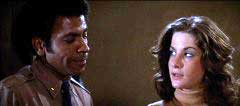 In
her first ever interview on a Carpenter disc, actress Nancy Loomis (12:42) has
surprisingly little to say about her films as an actress (she had come to Los
Angeles to be an actress and acted in student films at USC where she met Carpenter
and Wallace), but her behind the scenes work under ex-husband Wallace on set
decoration and wardrobe has led to an interest in sculpting (she is also teaching
theater). Of ASSAULT ON PRECINCT 13, she does discuss Carpenter's love of John
Ford and Howard Hawks and his attempt to give the ghetto a Monument Valley look
as well as the film's initial overseas success. The disc also includes the film's
theatrical trailer (2:02), two radio spots (1:03), and a still gallery. As with
Scream Factory's more deluxe collector's editions, ASSAULT ON PRECINCT 13 has
new artwork on the front of the cover – although much more in the original
spirit of the film than some of their other new designs – as well as original
artwork on the reverse (the cardboard slipcover of course showcases the newer
design). I'm not sure how this one compares to the Image Blu – or the
recent German combo – but the Scream Factory edition is the one to get
if you don't already have one of the others (and the new extras should be tantalizing
enough to Carpenter fans). (Eric
Cotenas)
In
her first ever interview on a Carpenter disc, actress Nancy Loomis (12:42) has
surprisingly little to say about her films as an actress (she had come to Los
Angeles to be an actress and acted in student films at USC where she met Carpenter
and Wallace), but her behind the scenes work under ex-husband Wallace on set
decoration and wardrobe has led to an interest in sculpting (she is also teaching
theater). Of ASSAULT ON PRECINCT 13, she does discuss Carpenter's love of John
Ford and Howard Hawks and his attempt to give the ghetto a Monument Valley look
as well as the film's initial overseas success. The disc also includes the film's
theatrical trailer (2:02), two radio spots (1:03), and a still gallery. As with
Scream Factory's more deluxe collector's editions, ASSAULT ON PRECINCT 13 has
new artwork on the front of the cover – although much more in the original
spirit of the film than some of their other new designs – as well as original
artwork on the reverse (the cardboard slipcover of course showcases the newer
design). I'm not sure how this one compares to the Image Blu – or the
recent German combo – but the Scream Factory edition is the one to get
if you don't already have one of the others (and the new extras should be tantalizing
enough to Carpenter fans). (Eric
Cotenas)